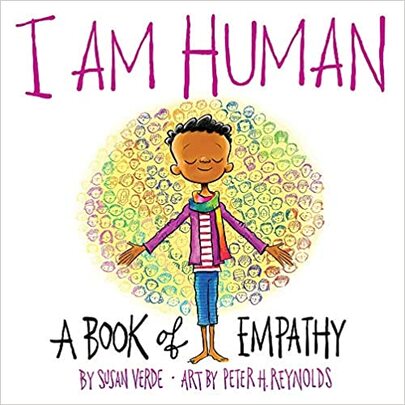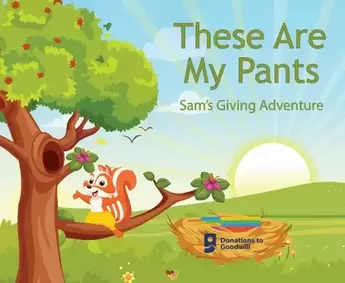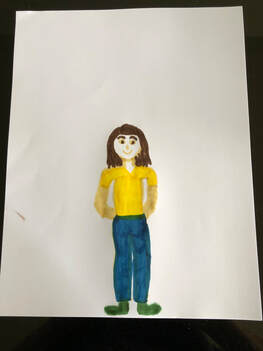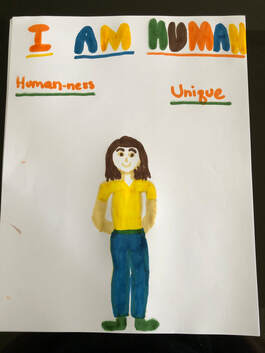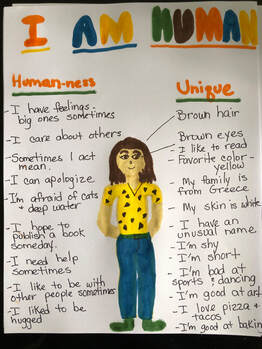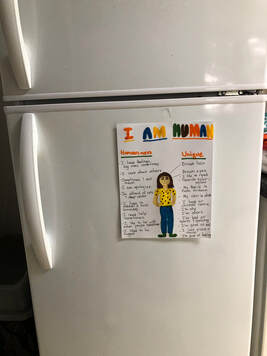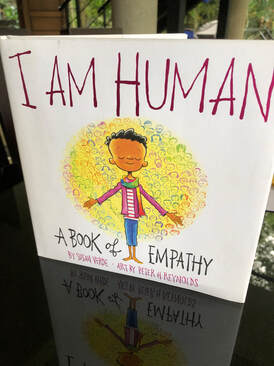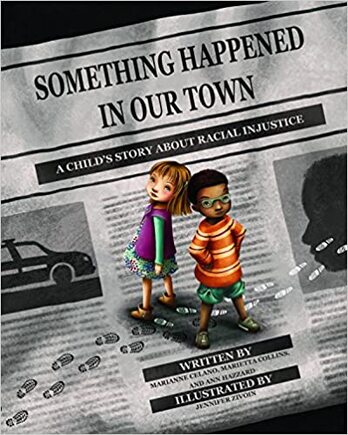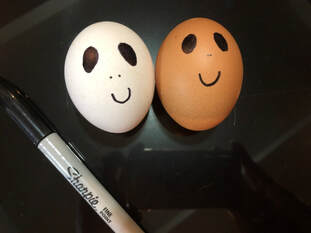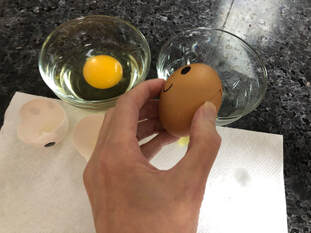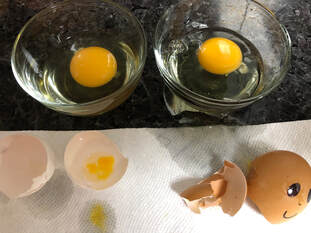A Book Review of |
| I Am Human A Book of Empathy Written By: Susan Verde Illustrated By: Peter H. Reynolds Published By: Abrams Books for Young Readers Recognizing our connection to each other through our humanity and empathizing with the plight of others is key to making this world a better place. I Am Human introduces these concepts to the youngest among us. It has become clear through this pandemic and the Black Lives Matter movement that our culture is lacking empathy and the ability to put ourselves in someone else's shoes. Teaching our children the importance of human connection, acceptance and empathy towards others will go a long way in improving our culture. The ability to care about the impact of our actions and behaviors on others is crucial. |
I Am Human sends an important message to all of us, but is most appropriate for children ages 3-8. Susan Verde skillfully weaves many layers into this simple book.
The larger take away is that we are all human. This sounds obvious, but the reality in this world is that is not how we treat each other. We are all human regardless of the color of our skin, different abilities, the country we are from, our religion or if we are from a poorer or richer part of town. We are all connected by our human-ness and are all unique in our own way. This book celebrates the human potential of feeling empathy and compassion toward ourselves and others.
The smaller messages relate to the fact that the human condition is imperfect. We all have our strengths and weaknesses and we should respect those things in ourselves and others. I Am Human is a hopeful book in that it portrays the journey of being human as having challenges and possibilities. We all have feelings that we express in different ways. Part of being human is being afraid of things sometimes or feeling sad occasionally or hurt or angry about something somebody said to you. We have the ability to make choices. We can apologize for our mistakes and try to do better. We can choose to be helpful to others if they are struggling or kind to ourselves.
The art by Peter H. Reynolds is simple, yet beautiful. It shows the connection between others and hopefulness of the human condition. The book includes a Loving/Kindness Meditation at the end.
I recommend this book for all children to teach them these human ideals from a young age and give them the reassurance and knowledge that they are part of something bigger and are not alone. It reinforces a sense of community that will help all of us get through difficult times. You can find this book and others in the I AM Series by Susan Verde and Peter H. Reynolds on her website at https://www.susanverde.com/susans-books.
As an example of showing empathy toward others, I recommend this follow up book that reinforces the joy of helping others.
The larger take away is that we are all human. This sounds obvious, but the reality in this world is that is not how we treat each other. We are all human regardless of the color of our skin, different abilities, the country we are from, our religion or if we are from a poorer or richer part of town. We are all connected by our human-ness and are all unique in our own way. This book celebrates the human potential of feeling empathy and compassion toward ourselves and others.
The smaller messages relate to the fact that the human condition is imperfect. We all have our strengths and weaknesses and we should respect those things in ourselves and others. I Am Human is a hopeful book in that it portrays the journey of being human as having challenges and possibilities. We all have feelings that we express in different ways. Part of being human is being afraid of things sometimes or feeling sad occasionally or hurt or angry about something somebody said to you. We have the ability to make choices. We can apologize for our mistakes and try to do better. We can choose to be helpful to others if they are struggling or kind to ourselves.
The art by Peter H. Reynolds is simple, yet beautiful. It shows the connection between others and hopefulness of the human condition. The book includes a Loving/Kindness Meditation at the end.
I recommend this book for all children to teach them these human ideals from a young age and give them the reassurance and knowledge that they are part of something bigger and are not alone. It reinforces a sense of community that will help all of us get through difficult times. You can find this book and others in the I AM Series by Susan Verde and Peter H. Reynolds on her website at https://www.susanverde.com/susans-books.
As an example of showing empathy toward others, I recommend this follow up book that reinforces the joy of helping others.
| These Are My Pants Written by: Jane and Katelyn Plank Ilustrated by; Aniqa Ashfaq This is a self-published book, that is not only about the virtue of giving to others, but also sets an example for giving as a portion of the book proceeds go towards Goodwill. I encourage you to purchase this book and use it as an example of being human and showing empathy toward others. |
Reading These Are My Pants provides an excellent opportunity to put the concept into action and have your child participate in an act of giving to others. It could be something of theirs that they are willing to give up to help others, something new that you buy together, or a service that the child can provide in the mission to help another human. Share the joy of giving with your child!
To learn more about These Are My Pants and to purchase the book, go to their website at https://www.plankbooks.com/.
To learn more about These Are My Pants and to purchase the book, go to their website at https://www.plankbooks.com/.
Activity Idea for I Am Human A Book Of Empathy
We are all connected with our human-ness, even though we are all unique in many ways. My suggestion is to pose two questions to your child after reading the book.
What makes you human?
What makes you unique?
Use those ideas to complete the following activity.
Materials needed:
8.5 x 11 paper or a roll of paper cut to the size of the child
markers or crayons
pencil
Directions:
If you have a roll of paper that you could have the child lay on and trace them, this would be the funnest way to continue. I don't have a paper roll or a child with me, so I will draw the child on a regular size paper. Either way is fine.
What makes you human?
What makes you unique?
Use those ideas to complete the following activity.
Materials needed:
8.5 x 11 paper or a roll of paper cut to the size of the child
markers or crayons
pencil
Directions:
If you have a roll of paper that you could have the child lay on and trace them, this would be the funnest way to continue. I don't have a paper roll or a child with me, so I will draw the child on a regular size paper. Either way is fine.
| 1. Have child lay on the paper on his/her back and trace around their body with a pencil. Then have child draw on and color their hair, eyes, clothes, etc. Or draw child outline on sheet of paper and have them color in details of themselves. Encourage them to make it look like their unique selves with hair color, skin color, eye color etc. Make sure to leave room around the drawing for writing. 2. Write I AM HUMAN at the top of the page and label one side with human-ness and the other, unique. 2. Around the portrait of themselves, discuss and write the things that make them both human and unique. The photo shows some examples. 3. Hang completed project on refrigerator or wall so they can see often. 4. Share with the child how you are different and the same as them. Have fun! |
3 Comments
A Book Review of Something Happened in Our Town- A Child's Story About Racial Injustice
| Something Happened in Our Town A Child's Story About Racial Injustice Written By: Marianne Celano, Marietta Collins, Ann Hazzard Illustrated By: Jennifer Zivoin Published By: Magination Press This current political climate, as stressful as it has been and continues to be, has awarded us an opportunity. An opportunity to be a part of stopping the cycle of systemic racism by teaching our children. As parents, teachers and therapists, we have been handed a teaching moment that comes with a responsibility to prepare our kids for a better future for ALL people. |
The recent incidents of police brutality toward people of color, and the treatment they receive that is very different from their white counterparts, is currently shining a light on a social issue that has been, and continues to be, a crisis within our communities. The news of the protests and the uptick of conversations around racial issues are, in fact, affecting our kids. They are watching and they are listening. As adults, we want to shield our kids from the ugly realities of the world. White people have had the privilege of not discussing race with their kids. This is part of the problem that needs to change. Therefore, it is crucial to have these discussions and this book is a perfect starting point.
One of the most important and effective things that we can do is to teach our children to pay attention to the world around them, to watch out for how others are treated and to stand up for themselves and others. Our children are our hope for a better future of equality for ALL people. We need to help them understand sameness and celebrate difference among people. This is our opportunity to check ourselves on how we are perpetrating the ongoing biases and disregard for people different from ourselves. We can learn along with our children.
Starting as young as 3 years old, numerous children of color that I encountered in my practice, verbalized to me that they thought they were ugly because of the color of their skin. There were also those who said they wanted to be white because that was better. Our society is teaching our precious children these falsehoods and it is our responsibility to make it stop!
This post may seem that it is directed more toward white children, but it is directed to all children. White children, however, have the most to learn about this issue due to a long history of disregard and discrimination of people of color perpetrated from their white heritage. White children are crucial in using their privilege to change the future. It is never too early to start talking about race. It is important to make this an ongoing conversation and to point out injustices that you or they may witness. Expose your children to people of color through real life activities, literature, music, etc.
Something Happened in Our Town was written in 2018, but was relevant long ago and, unfortunately, continues to be relevant to the experiences of today. It was written for children ages 4-8, however, I believe it is a learning tool for those from ages 4-99. Something Happened in Our Town offers a brief history of slavery and segregation, describes exactly who white and black people are, brings police brutality and racial inequality into light and encourages children to stand up for others and be allies. That is a lot for one children's book to cover, but it addresses these topics beautifully and with compassion.
The authors skillfully pull in the perspectives of a white and a black family, which makes the book relevant for all children and helps us see the perspective of the "other." After all, that is a big piece we are lacking as a society. The authors do not shy away from the big issues, but address them in an age appropriate, direct matter. The illustrations reflect the intensity of the subject matter and include powerful silhouettes that have a strong emotional impact throughout the book. Anger surrounding racial issues is addressed in the story and the character explains how it can be used as momentum to improve the world.
The conclusion pulls together what the children have learned through the conversations with their families. The two children, white and black, are in school when an immigrant boy arrives as a new student to their class. They notice how other students are mistreating the new student, and stand up for him. A lesson we all need to learn and develop the courage to uphold. Those children were the start of a better pattern in their school, which can carry over to the larger community over time.
The authors have provided a note to parents and caregivers at the end of the book with resources to help us continue to have these conversation with our children.
Below I have activity and discussion ideas to take this conversation to a deeper level.
One of the most important and effective things that we can do is to teach our children to pay attention to the world around them, to watch out for how others are treated and to stand up for themselves and others. Our children are our hope for a better future of equality for ALL people. We need to help them understand sameness and celebrate difference among people. This is our opportunity to check ourselves on how we are perpetrating the ongoing biases and disregard for people different from ourselves. We can learn along with our children.
Starting as young as 3 years old, numerous children of color that I encountered in my practice, verbalized to me that they thought they were ugly because of the color of their skin. There were also those who said they wanted to be white because that was better. Our society is teaching our precious children these falsehoods and it is our responsibility to make it stop!
This post may seem that it is directed more toward white children, but it is directed to all children. White children, however, have the most to learn about this issue due to a long history of disregard and discrimination of people of color perpetrated from their white heritage. White children are crucial in using their privilege to change the future. It is never too early to start talking about race. It is important to make this an ongoing conversation and to point out injustices that you or they may witness. Expose your children to people of color through real life activities, literature, music, etc.
Something Happened in Our Town was written in 2018, but was relevant long ago and, unfortunately, continues to be relevant to the experiences of today. It was written for children ages 4-8, however, I believe it is a learning tool for those from ages 4-99. Something Happened in Our Town offers a brief history of slavery and segregation, describes exactly who white and black people are, brings police brutality and racial inequality into light and encourages children to stand up for others and be allies. That is a lot for one children's book to cover, but it addresses these topics beautifully and with compassion.
The authors skillfully pull in the perspectives of a white and a black family, which makes the book relevant for all children and helps us see the perspective of the "other." After all, that is a big piece we are lacking as a society. The authors do not shy away from the big issues, but address them in an age appropriate, direct matter. The illustrations reflect the intensity of the subject matter and include powerful silhouettes that have a strong emotional impact throughout the book. Anger surrounding racial issues is addressed in the story and the character explains how it can be used as momentum to improve the world.
The conclusion pulls together what the children have learned through the conversations with their families. The two children, white and black, are in school when an immigrant boy arrives as a new student to their class. They notice how other students are mistreating the new student, and stand up for him. A lesson we all need to learn and develop the courage to uphold. Those children were the start of a better pattern in their school, which can carry over to the larger community over time.
The authors have provided a note to parents and caregivers at the end of the book with resources to help us continue to have these conversation with our children.
Below I have activity and discussion ideas to take this conversation to a deeper level.
Activity and Discussion Ideas for Something Happened in Our Town- A Child's Story About Racial Injustice
My first suggestion is to provide many books to children that include different races of people. Provide a variety that discuss the life hardships of people of color, as well as those that have a main character of a different race, feeling and experiencing the same day-to-day things as they do. The idea being understanding sameness and celebrating difference.
In the activity below, I have included many ideas for discussion. This is a difficult subject to discuss with children and these are just some ways to approach this sensitive topic.
Materials Needed
1 brown egg
1 white egg
black marker
2 small bowls
paper towel
In the activity below, I have included many ideas for discussion. This is a difficult subject to discuss with children and these are just some ways to approach this sensitive topic.
Materials Needed
1 brown egg
1 white egg
black marker
2 small bowls
paper towel
| Directions 1. Have the child CAREFULLY draw faces on each of the eggs with a black marker. 2. Ask the child what is the same between the outside of the two eggs. Clue: both are eggs, oval, same texture, etc. Ask them what is the difference between the two eggs. Clue: they are different colors. Ask them if they think they are the same or different inside? 3. Then, check it out to see! Have the child crack one egg into each bowl. Look at the eggs together. Are they the same inside? Compare this to people who have brown skin and white skin. Are all people the same outside? Nope. Are all people the same inside? Yep. Explain that some people, even some adults, even some policemen, don't understand that all people are the same on the inside and they treat people who look different on the outside unfairly. Refer to the policeman in the book. |
Do you think that people with different colored skin should be treated differently? Why? Why not?
So, our job, because we know that people are the same on the inside, is to stand up for those people who may be treated unfairly just because of the color of their skin. Discuss how the kids in the book did this with the new student.
Then, go deeper with the discussion. Why are people different colors?
People are different colors depending on where in the world they, or their ancestors, were born. Discuss where the child's ancestors were born and relate it to the color of their skin. Explain that most white people's ancestors are from Europe or other countries where the people are mostly white. Black people's ancestors are usually from Africa, Haiti, or the Caribbean. There are also people of other colors that come from different places in the world too. (A globe or world map can be helpful with this discussion.) But now, since their ancestors came to this country, many people of different colors are born in America, just like you(if that is true for them.)
Now, let's go even deeper. Should we pretend we don't notice that their skin is a different color?
No, we should celebrate all of our differences. Your skin color depends on where your ancestors are from. For that reason, skin color does make us different in ways that we can celebrate and enjoy about each other.
The fact that most of our ancestors are from different countries can bring with it different traditions like, food, music, art, rituals, religions that different families enjoy about their heritage. We wouldn't have the privilege to enjoy going to Chinese, Mexican, Indian, Moroccan, Ethiopian, or many other kinds of restaurants if people didn't bring these recipes from their native countries. What are some things that our/your family eat or does that have come from where you or your ancestors were born?
Ancestors also bring with them their history of experiences that can make life harder for them and the generations that come after them. One example of this is slavery, like we read about in the book. Many people with black skin had ancestors that were brought to the United States from Africa as slaves. They were treated very poorly by the people who were already here from Europe. Slavery finally ended, but black people still haven't caught up to having the same opportunities or being treated as well as white people.
These discussions don't have to be done all at once. This is the type of discussion that needs to be done repeatedly throughout the life of a child/adolescent/young adult. Children as young as 3 years old are aware of differences of skin color. Nurturing an understanding of others, empathy, and a sense of justice in our children will go a long way in helping to make the world a better place for ALL people.
So, our job, because we know that people are the same on the inside, is to stand up for those people who may be treated unfairly just because of the color of their skin. Discuss how the kids in the book did this with the new student.
Then, go deeper with the discussion. Why are people different colors?
People are different colors depending on where in the world they, or their ancestors, were born. Discuss where the child's ancestors were born and relate it to the color of their skin. Explain that most white people's ancestors are from Europe or other countries where the people are mostly white. Black people's ancestors are usually from Africa, Haiti, or the Caribbean. There are also people of other colors that come from different places in the world too. (A globe or world map can be helpful with this discussion.) But now, since their ancestors came to this country, many people of different colors are born in America, just like you(if that is true for them.)
Now, let's go even deeper. Should we pretend we don't notice that their skin is a different color?
No, we should celebrate all of our differences. Your skin color depends on where your ancestors are from. For that reason, skin color does make us different in ways that we can celebrate and enjoy about each other.
The fact that most of our ancestors are from different countries can bring with it different traditions like, food, music, art, rituals, religions that different families enjoy about their heritage. We wouldn't have the privilege to enjoy going to Chinese, Mexican, Indian, Moroccan, Ethiopian, or many other kinds of restaurants if people didn't bring these recipes from their native countries. What are some things that our/your family eat or does that have come from where you or your ancestors were born?
Ancestors also bring with them their history of experiences that can make life harder for them and the generations that come after them. One example of this is slavery, like we read about in the book. Many people with black skin had ancestors that were brought to the United States from Africa as slaves. They were treated very poorly by the people who were already here from Europe. Slavery finally ended, but black people still haven't caught up to having the same opportunities or being treated as well as white people.
These discussions don't have to be done all at once. This is the type of discussion that needs to be done repeatedly throughout the life of a child/adolescent/young adult. Children as young as 3 years old are aware of differences of skin color. Nurturing an understanding of others, empathy, and a sense of justice in our children will go a long way in helping to make the world a better place for ALL people.
Follow me on Twitter, Pinterest and LinkedIn
Categories
All
Absent Dad
Acceptance & Commitment -Therapy Skills
Acceptance Of Others
ADHD
Adoption
Anger Management
Anxiety
Body Autonomy
Cognitive Behavioral Therapy Skills
Consent
Coping With ADHD
Coping With Depression
Coping With Feelings
Depression
Disability Awareness
Disappointment
Divorce
Domestic Violence
Empathy
Fear
Feelings General
Feelings-General
Foster Care
Gender Identity
Giftedness
Grandparents As Guardians
Grief & Loss
Growth Mindset
Incarcerated Parent
Kindness
Kinship Care
Learning Disabilities
Making Friends
Mindfulness
Negative Self Talk
Parental Anger
Parental Arguing
Parent W/Mental Illness
Parent W/Substance Abuse
Racial Injustice
School Lockdown Drills
Seizures
Self Esteem
Sensory Issues
Separation Anxiety
Sexual Abuse
Sexual Abuse Prevention
Shyness
Standing Up For Others
Suicide
Supporting A Friend
Temper Tantrums
Terminal Illness
Trauma
White Privilege
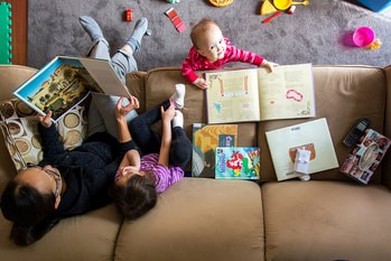
 RSS Feed
RSS Feed
